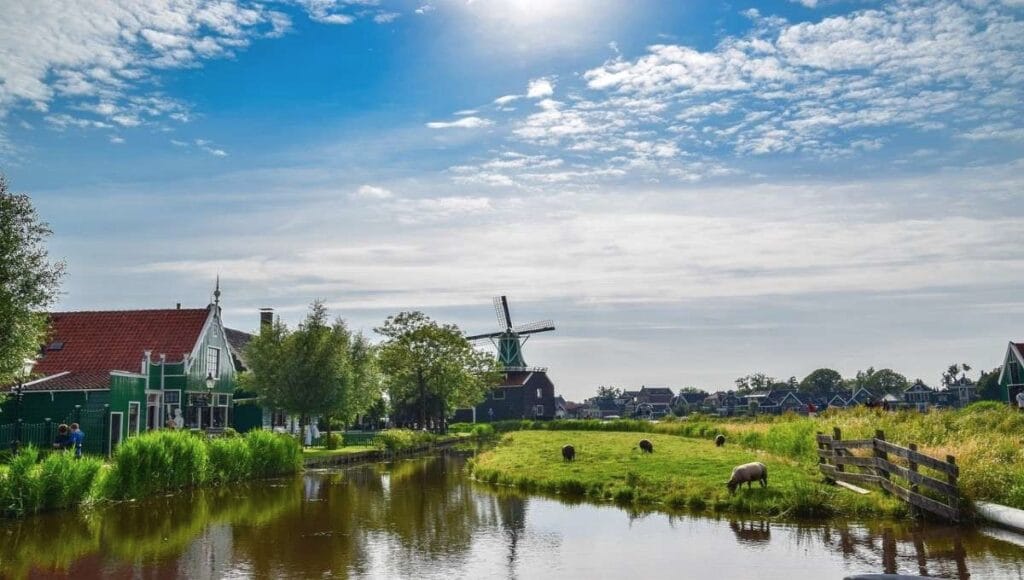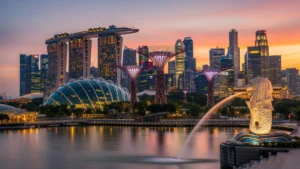The country of the Netherlands is well known for its various literacy and artistic traditions, thus giving more than one place to visit. Zaanse Schans gives the tourists a chance to visit primitive isles, key magnates, and stores maintaining Dutch creation.
Delft is infamous for its distinctive blue-and-white tableware and for being home to painter Johannes Vermeer. Giethoorn, called the “Venice of the North,” charms with its picturesque canals and interesting car-free environment. Haarlem is an equally rich literary shade, offering wonders of medieval defenses and artistic treasures like the Teylers museum as well. These destinations in concert present a pictorial portrayal of the artistic and imaginative literary heritage of the country of Netherlands.
Budget Summary
| Destination | Luxury (per day) | Mid-Range (per day) | Budget (per day) |
|---|---|---|---|
| Zaanse Schans | $190-$330 | $130-$200 | $100-$150 |
| Keukenhof Gardens | $200-$350 | $140-$210 | $110-$160 |
| Kinderdijk | $195-$330 | $145-$200 | $100-$150 |
| Delft | $200-$350 | $150-$210 | $90-$130 |
| Giethoorn | $195-$340 | $140-$200 | $105-$150 |
| Haarlem | $200-$350 | $150-$210 | $110-$160 |
1. Zaanse Schans

A delightful rustic settlement that transports its visitors to yesteryears pleasant times. This beautiful region is famous for the remarkable old windmills that were once used for various industrial activities such as spice grinding, wood cutting, and oil extraction. The Village is, so to speak, an outdoor museum filled with authentic Dutch architecture; inhabited houses, Barns and workshops devoted to the rich heritage of the nation This includes but is not limited to the clog workshop, where traditional wooden shoes are handmade as a bridge between past and present.
Also the traditional cheese farm stands out, where one can learn about the cheese making process and munchee on several kinds of Dutch cheese. Zaanse Schans has the Most Beautiful Scenes with its Lovely windmills green fields and Zan River, Thus It’s a favorite destination of the photographers This area symbolizes the East zaan district which was an industrial era in the 17th century and the first of its kind in the world. Visit the Colonial Shipyard to discover about the process of traditional Dutch ship building Finally Visit the Dutch Bakery Museum and see how traditional Dutch cookies and bread baking was done and which also provides samples of delicious snacks.
2. Keukenhof Gardens

The biggest flower garden in the world, occupying over 79 acres of land, is appropriately dubbed as a flower paradise. Every year, about 7 million flower bulbs including tulips, hyacinths, and daffodils among others are planted. The history of Keukenhof goes back to the 15th century when the place became tradition of a kitchen garden for a castle nearby with herbs and vegetable supplies. Keukenhof is usually only opened between latter part of March to mid May for few weeks every year making it seasonal attraction for world wide visitors of over 1.5 million per year.
New theme decides what’s going to be main every year in the flower mandate Anubis’s hornets dune everything including hares the tulips one On the base of the Tulips other Flowers Keukenhof also has few Roses Liles Orchid’s The design of the Garden incorporates meandering walks, water bodies and theme gardens which offers the major another attraction which is a tranquility and beautiful atmosphere to the visitors, also, holds many floral exhibitions throughout its open period presenting flower arrangements and general horticulture.
To ensure the continuity of the gardens’ splendour, organic bulbs with organic gardening methods are put in practice. Keukenhof Gardens is living evidence of how beautiful nature is and will always be and is one place I would recommend without any doubt anyone going to Holland spring period.
3. Kinderdijk

The picturesque Kinderdijk has been inscribed in the UNESCO World Heritage list for over two decades. This area is famous for the eighteen century windmills built for the water management system, the time-defying structures relate to the Advanced Dutch water-management system of canals, dikes, and pumping basins that have for many centuries been used for the containment of water. Some of the windmills are functional and opened to the public demonstrating their wonderful working mechanisms. The Visitor Center includes displays as well as programs in which people may learn about the history and science of the Dutch waterworks and water management, and seek much employed helpful assistance.
Happy embarking on boats on canals to catch a closer glimpse of the wind mill structures and the adjacent landscape elements. Kinderdijk is also one of the areas where all photographers want to be at, owing to the views that make it photogenic, especially during where the sun rises and when the sun is set. At all the seasons of the year, there are cultural activities as well as Dutch celebrations of the national day, which show off the way of life of the people. If biking is your forte, you can enjoy the use of some bike trails around Kinderdijk and see some of the sites at the scenic views at you own time.
4. Delft

Delft is also known for its many lovely canals which make it similar to Amsterdam within its boundaries and quite pretty as well, it also just so happens to be the birthplace of Vermeer whose masterpieces including the Girl with a Pearl Earring were inspired by the beauty of the city. Delft is considered the home of the New York new church one of the finest places in delft as it holds the burial Vault of the Royal Family, walking up the Tower of the church provides breathtaking panoramas of the entire city.
An equally important historical and architectural monument is the Oude Kerk, notable for its floor level leaning tower. For those interested in engineering, Delft is home to the well-known school of engineering known as Delft University of Technology Tu Delft which is among the top engineering schools in the world. As regards to the city’s renowned Pottery, the Royal Delft experience provides the visitors with an opportunity to know and see the art and history behind delft ware with demonstrations and a museum. One of the largest markets in Europe which is the Central Market Square market is accompanied by many older structures including the city hall.
Prinsenhof Museum, the second important site, is situated in a former monastery which had been the residence of William of Orange, known as the father of the Dutch nation. The city of Delft like much of Netherlands is very bicycle oriented and there are many cycling paths and places to rent a bicycle. To better understand its historical perspective together with its natural sights should be done on a bike in Delft.
5. Giethoorn

The captivating Dutch village of Giethoorn, stylishly designated as “The Venice of the North,” is famous for its intricate waterways and the absence of roads in the core of the village. Giethoorn, has no main roads and the people are restricted to travel in canals by means of boats, or on foot, or through bicycles. Children in the village have to cross more than 1050 wooden bridges, making it infinitely more beautiful.
Apart from those features Giethoorn contains numerous thatched roofed houses built hundreds of years ago as far back as the 18th century showing how old and rich the place is. With a lot of greenery in the De Weerribben-Wieden National Park, a European wetland of global significance, Giethoorn is breathtaking. There are also electrically powered `whisper’ boats to protect the mellowness of the place because they are impressively quiet. Also, canoeing, kayaking, and sailing are some of the water sports most enjoyed here, Giethoorn.
Rich is the cultural heritage of the Village with numerous museums with history on display, such as the Overholland Museum. The first foreign one was a Dutch comedy film Fanfare which was shot in this village and made it famous across the globe. Giethoorn horn however, despite its small size, lures several hundred thousands of visitors every year due to its appealing beauty and Sandy sceneries.
6. Haarlem

One more survey to conclude. Harlem is uncommonly beautiful and Historically interesting City Situated not far from Amsterdam. Lovely roads, eventful past and culture; Harlem is rich in history and is one of the best places to visit in the Netherlands.
And mark your steps at the Teylers Museum. This museum, which opened its doors in 1778, is distinguished as the oldest museum in the Netherlands and has on display interesting exhibits of both art and natural history as well as scientific devices. It’s a place where history and curiosity Collide and brings the best out of its patrons.
The other name of the Grote Kerk, St. Bavokerk, Is a grand Gothic church built in the 14th century which is famous for its Müller organ that was played by Mozart. The church’s architecture and its encouraging place in history stands as equal attraction in Haarlem.
While in Haarlem, take the time to visit the city’s tranquil hofjes. These peaceful courtyards, surrounded by historic houses that often date back to the medieval era, provide a quiet escape from the bustling city and offer a fascinating glimpse into Haarlem’s history.
In Haarlem, be sure to pay every attention to the city’s serene hofjes. Enclosed where you often get medieval architecture to houses that you would pay a visit more than often, these quirky courtyards provide some relief from the busy city and enable you to learn some of the things hitherto unknown from the history of Haarlem.
Take a look at the city gate in Amsterdam Forged in the 14th century, the place is the only surviving city gate of the twelve that were encompassed in the City Of Haarlem. This structure is a wonderful nice glimpse into the Medieval time of Haarlem and it is also a iconic Landmark.
Jopen Brewery, while located in a church, is a relaxing craft beer location and must be visited by beer lovers, because a mix of history with modern craft brewing creates a very enjoyable atmosphere. The diversity in taste provides a glimpse into the history of brewing in Haarlem, which comes with unique and modern variants. The Spaarne River passes from the city of Haarlem enhancing the picturesque experience along with the option of taking peaceful boat rides around the city. Kenaupark is central for visitors interested in the scenery; being the first public park in the Netherlands, it has relaxing pathways, a great children’s farm, and an old pavilion making it a perfect venue for a pleasant walk.
The city occupies a special position in the printing history Laurens Janszoon Coster is reputed to have produced movable type around the same period as Gutenberg. But many of the well known facts concerning this historical episode are evidence of local chauvinism and, respectively, enhance the culturally rich tapestry of the city.
The De Adriaan windmill built in 1779 and remodel is one of the notable monuments in Haarlem. The historic windmill now provides tours and exhibits and focuses on its history and purposes making it an important site for Dutch culture.
When in Haarlem at Christmas time, make sure you visit the Christmas Market which is considered host one of the best in the Netherlands. This market makes the city a different and beautiful atmosphere with lovely stands, pretty lights and the great spirit of Christmas.
Conclusion
Travel to the Netherlands and you will find plenty of historical and cultural places which are interesting in their own ways and history. Starter from the delicate windmills along with Dutch style houses in Zaanse Schans to blooming flower in Keukenhof, each site has its place in the history and culture of the nation. This place is famous for its windmills, and effortlessly so, considering the feats of the Dutch with regards to the management and control of water.
Delft’s famous blue delft and buildings built during the Renaissance are surely captivating. Giethoorn, with its peaceful waters and houses ‘armored’ with thatch roofs invites the traveler to take things easy; and Haarlem, with stunning history and rich traditions of arts completes the journey through the Netherlands. Taking all these places together enhances not just cultural identity of the Netherlands, but also the profound understanding of the way this nation cohabits with its lands and past, thus making them deserving facts for any cultural or historical voyager.











